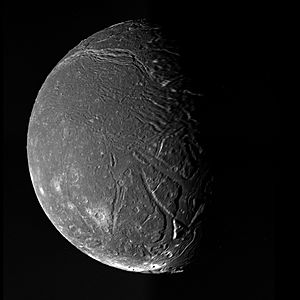Ariel (moon) facts for kids

Ariel in greyscale by Voyager 2 in 1986. Numerous graben are visible, including the Kachina Chasmata canyon system stretching across the upper part of the image.
|
|||||||||
| Discovery | |||||||||
|---|---|---|---|---|---|---|---|---|---|
| Discovered by | William Lassell | ||||||||
| Discovery date | 24 October 1851 | ||||||||
| Designations | |||||||||
| MPC designation | Uranus I | ||||||||
| Pronunciation | or | ||||||||
| Adjectives | Arielian | ||||||||
| Orbital characteristics | |||||||||
| 191020 km | |||||||||
|
Mean orbit radius
|
190900 km | ||||||||
| Eccentricity | 0.0012 | ||||||||
| 2.520 d | |||||||||
|
Average orbital speed
|
5.51 km/s | ||||||||
| Inclination | 0.260° (to Uranus's equator) | ||||||||
| Satellite of | Uranus | ||||||||
| Physical characteristics | |||||||||
| Dimensions | 1162.2 × 1155.8 × 1155.4 km | ||||||||
|
Mean radius
|
578.9±0.6 km (0.0908 Earths) | ||||||||
| 4211300 km2 | |||||||||
| Volume | 812600000 km3 | ||||||||
| Mass | (1.251±0.021)×1021 kg | ||||||||
|
Mean density
|
1.592±0.15 g/cm3 | ||||||||
| 0.25 m/s2 | |||||||||
| 0.537 km/s | |||||||||
| synchronous | |||||||||
| Albedo |
|
||||||||
|
|||||||||
| 14.4 (R-band) | |||||||||
Ariel is one of the 27 known moons that orbit the planet Uranus. It is the fourth largest of these moons. Ariel orbits and spins around Uranus in a special way. Its path is almost straight up and down compared to Uranus's orbit around the Sun. This means Ariel has very extreme seasons!
Ariel was discovered in October 1851 by a scientist named William Lassell. It was named after a character from two famous stories. Most of what we know about Ariel comes from a single visit by the Voyager 2 space probe in 1986. Voyager 2 flew past Uranus and managed to take pictures of about 35% of Ariel's surface. Right now, there are no plans to send another spacecraft to study Ariel up close.
Ariel is the second-smallest of Uranus's five main round moons. It is also the second closest moon to Uranus. It is one of the smaller spherical moons in our Solar System. Scientists believe Ariel is made of about half ice and half rock. Its total mass is roughly the same as all the water on Earth!
Like all of Uranus's moons, Ariel probably formed from a big disk of dust and gas. This disk was around Uranus shortly after the planet formed. Scientists think Ariel has different layers inside, like Earth. It likely has a rocky core surrounded by a thick layer of ice. Ariel's surface is very interesting. It has many craters, but also deep canyons and long ridges. These features show that Ariel has been geologically active more recently than other moons of Uranus. This activity was probably caused by tidal heating, which is like a squeezing and stretching effect from Uranus's gravity.
Exploring Ariel

Ariel is quite dim when seen from Earth. It's about as bright as Pluto. However, because it's so close to the bright glare of Uranus, it's hard to see even with large telescopes.
The only close-up pictures of Ariel were taken by the Voyager 2 probe. This spacecraft flew past Uranus in January 1986. Voyager 2 got very close to Ariel, about 127,000 kilometers (79,000 miles) away. This was closer than it got to any other Uranian moon except Miranda. The best pictures of Ariel show details as small as 2 kilometers (1.2 miles). These pictures cover about 40% of Ariel's surface. However, only 35% of the surface was clear enough for scientists to make detailed maps and count craters. When Voyager 2 flew by, Ariel's southern half was facing the Sun. This meant the northern, dark half could not be studied. No other spacecraft has ever visited Uranus or its moons.
Ariel's Shadows
Sometimes, Ariel passes directly in front of Uranus from our view on Earth. This is called a transit. During a transit, Ariel casts a shadow on Uranus's cloud tops. On July 26, 2006, the Hubble Space Telescope captured one of these rare events. These transits don't happen often. They only occur around the times of Uranus's equinoxes. This is because Ariel's orbit around Uranus is tilted almost straight up and down compared to Uranus's orbit around the Sun. Another transit was seen in 2008 by the European Southern Observatory.
See Also
 In Spanish: Ariel (satélite) para niños
In Spanish: Ariel (satélite) para niños
- List of natural satellites
- Planetary Science Decadal Survey
Images for kids




